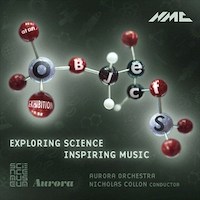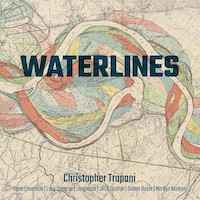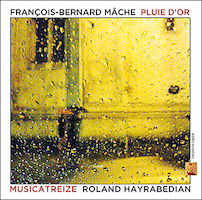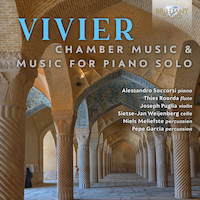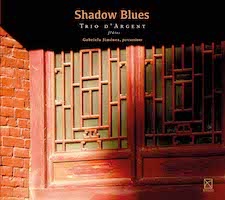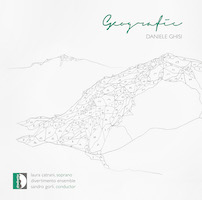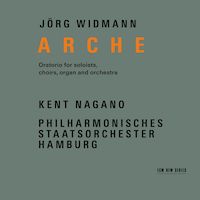Ramble with Artificial Limb
|
Grant Chu Covell [March 2021.]
“Objects at an Exhibition.” Thea MUSGRAVE: Power Play (2015). Christopher MAYO: Supermarine (2015). Claudia MOLITOR: 2TwoLO (2015). David SAWER: Coachman Chronos (2014). Gerald BARRY: The One-Armed Pianist (2015). Barry GUY: “Mr. Babbage is Coming to Dinner!” (2015). Aurora Orchestra, Nicholas Collon (cond.). NMC D215 (1 CD) (www.nmcrec.co.uk). Six composers were asked to write pieces which respond to exhibits or objects in the London Science Museum. The pieces were premiered in the halls near their inspirations. Musgrave’s Power Play, a six-minute arioso as if from a Brandenburg, reflects machines in the museum’s Energy Hall. Mayo’s Supermarine features a cello and bass duo, but with four samplers adding sounds of airplane engines, was inspired by a slate statue of the aeronautical engineer R.J. Mitchell who designed the Spitfire aircraft. Molitor’s 2TwoLO commemorates the BBC’s first radio transmitter and includes archival material from 1922 as the instruments move from taps and clicks into a distorted excerpt from Xerxes. Suggested by an 1820 Royal Mail coach, Sawer’s Coachman Chronos reflects a previous era’s sensation of reckless travel and includes a part for flugelhorn. Barry started with an artificial limb: The One-Armed Pianist repeats the same limping two-chord gesture in different guises and then obsesses over a repeated octave. Guy’s graphic score (miniaturized on the booklet cover) takes its cue from engineering drawings for one of Babbage’s machines. Musgrave’s effort seems the most traditional; Barry’s is instantly memorable.
“Waterlines.” Christopher TRAPANI: Waterlines: Five Songs about Storms and Flooding (2005; 2012)1; Passing Through, Staying Put (2011)2; Visions and Revisions (2013)3; The Silence of a Falling Star Lights up a Purple Sky (2005)4; Cognitive Consonance (2010)5. Lucy Dhegrae1 (voice), Longleash2, JACK Quartet3, Marilyn Nonken4 (pno), Didem Başar5 (qanûn), Christopher Trapani5 (hexaphonic electric guitar), Talea Ensemble1,5, James Baker1,5 (cond.). New Focus Recordings FCR 200 (1 CD) (www.newfocusrecordings.com). As cliches go, “unclassifiable” is wonderful to hide behind. However, Trapani’s album is in actuality hard to pinpoint because of the seamless blend of spectralism, Delta Blues, Turkish instruments (and tuning), and good old-fashioned Rome Prize creds. Waterlines would not have been written if it weren’t for Katrina’s devastation. The song cycle reflects the disaster, although it is lively and perplexing with agitated singer and backup. The rest of the release suggests a different composer, but the same playful energy prevails. Passing Through, Staying Put is a miniature two-part piano trio whose contradictions are difficult to pin down. Visions and Revisions holds folksy tunes disguised with pizzicato, flashing glissandos and other modern string quartet maneuvers. The Silence of a Falling Star Lights up a Purple Sky might be the only piece here limited to a conventional tuning even though the piano is lightly prepared (dampened strings). The cleverly titled Cognitive Consonance breaks the concerto mold. A microtonal Turkish qanûn (zither) steps forward in the first movement, Disorientation. A dazzling but brief electronic interlude leads to Westerling where the composer himself struts on a hexaphonic guitar (each string can resonate independently).
“Pluie d’Or.” François-Bernard MÂCHE: Safous Mélè (1958-59)1; Danaé (1970)2; Heol Dall (2003)3; Invocations (2017)4. Marie-George Monet1 (c-alt), Musicatreize: Céline Boucard1,2, Claire Gouton1,2,3,4, Hélène Richer1, Marion Schürr1, Kaoli Isshiki2,3, Elise Deuve3 (sop), Laure Ilef1, Estelle Corre1,2,3, Pauline Leroy1, Madeleine Webb1, Sarah Breton2,3,4, Marie-George Monet2,3,4, Sarah Breton3 (alt), Jérôme Cottenceau2,3, Xavier de Lignerolles2,3,4, Gilles Schneider2,3 (ten), Patrice Balter2,3,4, Éric Chopin2,3, Grégoire Fohet-Duminil2,3, Jean-Manuel Candenot4 (bass), Jean-Louis Beaumadier1 (pic), Véronique Charpentron1 (fl), Guillaume Deshayes1, Patrice Barsey1 (ob), Célia Perrard1 (hp), Raphaël Simon1,4, Christian Hamouy1,2,4 (perc), Nathanaël Gouin3, Sélim Mazari3 (pno), Roland Hayrabedian (cond.). l’empreinte digitale ED13257 (1 CD) (www.empreintedigitale-label.fr). Mâche’s distinctive vocabulary connects music with speech and natural sounds. Some works imitate animals, such as Korwar (1972) for harpsichord and tape, whereas other pieces explore phonetics or deconstruct texts. On this program, multi-part choruses take precedence. Safous Mélè adds singers to an ensemble of two flutes, two oboes, harp and percussion. In Danaé and Invocations percussion accompanies the chorus, and in Heol Dall two pianos support the voices. Safous Mélè takes fragments of Sappho, sets them for contralto, but also encodes the text into musical pitches and sounds. Rhythms are derived from the ancient Greek, and letters are encoded into pitches and events (consonants like D or T are played on tambourine, etc.). The cryptography is easily overlooked. Apparently, Messiaen noted Mâche’s technique and tried it himself. There are six songs, mysterious and potent. The alluringly energetic Danaé was written for the Shiraz Festival and premiered in Persepolis, Iran. The chorus’ actions (speech, noises, singing, etc.) are precisely notated, suggesting incomprehensible mysteries. Mâche was also inspired by a recording of a Hunza song from Kashmir. The piece is dedicated to Mâche’s close friend Xenakis. Like Danaé, Heol Dall asks for twelve voices, but accompanied by two pianos instead of percussion. Heol Dall means “the blind sun” in the ancient language of Brittany, but texts are by Sappho and Novalis and sung in Greek and German. Mâche says: “I collected texts where death is not a final end but a revelation.” The piano writing is agitated and rhythmic. Invocations sets vowels from the Egyptian Book of the Dead. The chorus is a mixed half-dozen. The ancient papyri used seven Greek vowels (linked to the days of the week), and consequently, Invocations has no text, only voices singing vowels. These dazzling works bear repeating and close inspection.
“Chamber Music & Music for Piano Solo.” Claude VIVIER: Shiraz (1977)1; Pulau Dewata (1977; arr. A. SOCCORSI, 2018)2; Pièce pour Violoncelle et Piano (1975)3; Pianoforte (1975)4; Paramirabo (1978)5. Alessandro Soccorsi1,2,3,4,5 (pno), Thies Roorda5 (fl), Joseph Puglia5 (vln), Sietse-Jan Weijenberg3,5 (vlc), Niels Meliefste2, Pepe Garcia2 (perc). Brilliant Classics 96082 (1 CD) (www.brilliantclassics.com). Vivier (1948-83) went his own way during his truncated life, offering meandering but assured melodic lines influenced by Eastern travels. The seven-minute Pièce for cello and piano encases unsettling pairings, alternating held notes and low rumbles. Paramirabo for flute, violin, cello and piano offers trembling unisons and its players must whistle as well. The piano’s repeated chords may spoof Stockhausen, and quick gestures recall Messiaen’s aviary, although Vivier tends towards the sinister if not willfully bewildering. Pianist Soccorsi is this program’s chief instigator, taking two solos which bury the Fibonacci series underneath quirky spun melodies. Pianoforte’s eight minutes ends with a bewildering effect of strong chords in the left hand with barely audible higher notes in the right. Shiraz might be the most familiar item, sectional, reflecting something Eastern but not quite. Pulau Dewata can be arranged in an infinite number of ways. Vivier wrote treble material of repeated chords (the Fibonacci series again) and notes in irregular meters, very much influenced by Gamelan music, but not specifying instrumentation. Soccorsi has created an arrangement for piano and pitched percussion.
“Shadow Blues.” Luc FERRARI and François Daudin CLAVAUD: Temple, Halong Bay, Bicycles and Trains, Metals Street, Entering a Restaurant (1995-97). TAO YU: Fleurs de prune tombantes (2011)1. François Daudin CLAVAUD: Shadow Blues (2006)2; Mirior (1997)3. Tran Thi KIM NGOC: La sieste d’une jeune fille (1995)4. Thierry PÉCOU: Princesse Iwa (1997)5. Trio d’Argent1,2,3,4,5: François Daudin Clavaud, Xavier Saint-Bonnet, Michel Boizot (fl), Tao Yu1 (narrator), Gabriela Jiménez2 (perc). Urtext Online JBCC302 (1 CD) (www.urtextonline.com). Three flutes transport us to Asia. Well not quite. We hear the sounds of Hanoi interwoven with pieces inspired by Chinese, Japanese and Vietnamese sources. Edited field recordings between pieces contextualize the compositions which reflect all nature of influences and cultures. The title piece, Shadow Blues, is the longest, and asks for a range of flutes including piccolos and bamboo flutes, as well as sho and percussion. The eight movements, or images, were sparked by Junichico Tanizaki’s Praise of the Shadows, and explicitly balance Chinese, Japanese and Buddhist symbolism with the five senses and a perception of light and shadow. There are moments where the flutes echo ancient court styles or flirt with pentatonic scales. Flourishes imitate the imagined forerunners of Das Lied von der Erde. The pieces invent and imitate, mixing genres. Towards the end of Tao Yu’s Fleurs de prune tombantes (“Falling Plum Blossoms”) a Tang Dynasty poem appears. The composer recites it herself here. Scored for bass flutes, the pushed breaths are more ominous than picturesque. La sieste d’une jeune fille, a tiny two-minute song arrangement for flute trio, presents a Vietnamese picture. Mirior is also short, canonically constructed, and derived from Clavaud’s interpretation of a Chinese landscape painting. Similarly, in Princesse Iwa, Pécou invents a canonic ritual punctuated with tam-tam and recalling 4th-century Japan. For the Ferrari completist, here are five brief electroacoustic pieces. Clavaud had made field recordings during the trio’s Vietnam residency and suggested that Ferrari explore them. They are looped and collaged audio postcards, and in concert they were used to back the set changes. Like the instrumental pieces, they refract their sources, retaining motivic if not contextual fidelity. The final track is an uncredited traditional tune performed by a Shanghai conservatory orchestra. Festive and jarring, all recordings are approximations.
“Geographie.” Daniele GHISI: Próxima (2011-12)1; iCi (en écho) (2010)2; abroad (2010-11)3; Concertino (2011)4. Laura Catrani1,3 (sop), Divertimento Ensemble1,3,4, Sandro Gorli1,3,4 (cond.). Stradivarius STR 37053 (1 CD) (www.stradivarius.it). Completed within a short span, these four works provide a concentrated plunge into Ghisi’s world. However, inconsistencies suggest uneven strategies or a composer still working things out. The 15-player Concertino is the finest item. Briskly moving material is lightheartedly juggled over steadier sounds, sometimes noises. The score indicates: “Flute, Oboe, Clarinet and Bassoon need to have some rather sonorous candy wrappers.” Easily overlooked, an allusion to Tristan und Isolde lurks towards the end. Ghisi hopes we appreciate his references and semantic manipulations. However, such schemes do not always make for interesting music. Próxima sets three poems by Gustavo Adolfo Becquer (for soprano, flute, clarinet, piano, viola and cello) and abroad includes seven songs to Fernando Pessoa (for soprano, flute, clarinet, trumpet, piano, percussion, string trio and electronics). The smaller collection is more effective. The electroacoustic iCi (en écho) clumsily explores Lewis Carroll’s Through the Looking Glass. Bits of Schumann and Schubert squirm without sticking. But the Concertino is worth a detour.
Jörg WIDMANN: ARCHE (2016). Marlis Petersen (sop), Thomas E. Bauer (bar), Iveta Apkalna (org), Philharmonisches Staatsorchester Hamburg, Kent Nagano (cond.). ECM 2605 (2 CDs) (http://www.ecmrecords.com/). No doubt Ligeti and B.A. Zimmermann would be glad for the company of this grand rambling oratorio which may have made more sense in the 1960s or ’70s rather than the last decade. Written to consecrate the new Hamburg Elbphilharmonie, Widmann treats us to a stylistic goulash with Bachian chorales, musical quotes (and jokes), spluttering organ riffs, narration, solo voices, parodies of sports cheers and waves of imposing orchestral boisterousness. The constant flux may fatigue, but then a tranquil patch will startle. The fourth part, Dies Irae, and the concluding Dona Nobis Pacem make for a particularly wild ride. Beethoven’s Choral Fantasy has a big role in the Dies Irae. The title (chest or coffer in Latin, beginning or origin in Greek) hints at an all-encompassing creation myth; the hour-and-forty-one minutes provide a vision of human history (predominantly European) that parallels the Latin Mass. Texts run the gamut from the Bible and the Mass to Schiller, Brentano, Nietzsche and Michelangelo. This fine recording, superbly showcasing soloists, chorus and orchestra, demonstrates that the Elbphilharmonie is a fine musical space. Widmann’s score presents countless interesting moments suggesting he should be churning out operas, however, the whole shebang is disorienting. It would have been impossible to attend the January 2017 premiere and not laugh out loud (alternately awkwardly and enjoyably) at so many places.
Barry, Clavaud, Ferrari, Ghisi, Guy, Kim Ngoc, Mâche, Mayo, Molitor, Musgrave, Pecou, Sawer, Soccorsi, Tao Yu, Trapani, Vivier, Widmann
[More Grant Chu Covell, Rambles]
[More
Barry, Clavaud, Ferrari, Ghisi, Guy, Kim Ngoc, Mâche, Mayo, Molitor, Musgrave, Pecou, Sawer, Soccorsi, Tao Yu, Trapani, Vivier, Widmann]
[Previous Article:
Used Bin Troll Tweets WW.]
[Next Article:
Used Bin Troll Tweets XX.]
|
